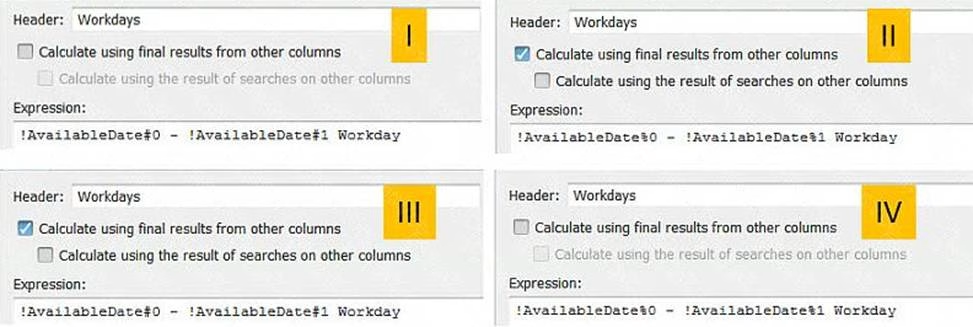Kinaxis KX3-003 Certified RapidResponse Author Level 3 Exam Online Training
Kinaxis KX3-003 Online Training
The questions for KX3-003 were last updated at Apr 07,2025.
- Exam Code: KX3-003
- Exam Name: Certified RapidResponse Author Level 3 Exam
- Certification Provider: Kinaxis
- Latest update: Apr 07,2025
A client wants to provide their sales staff the ability to add forecasts for the global total of demand across all SKUs by each customer by month. The client wants to use their historical demand to allocate from a monthly forecast to a weekly forecast.
Which three actions would accomplish this task? (Choose three.)
- A . Create a worksheet based on the HistoricalDemandActual table.
- B . Create workbook variables for Start Date and End Date.
- C . Create a workbook variable for Calendar with a value of Month.
- D . Define a custom Insert Definition.
- E . Include only columns for Part, Site, and Customer from the HistoricalDemandActual table.
You want to control how available dates are calculated for your vendor managed parts’ supplies and demands.
In this situation, which control table would you need to configure?
- A . AvailableRule
- B . DemandType
- C . OrderPolicy
- D . SupplyType
You are asked to create a workbook that identifies the change in IndependentDemandAvailableDate in workdays from a child scenario to its parent.

Which worksheet properties shown in the graphic identifies the correct configuration and expression?
- A . I
- B . II
- C . III
- D . IV
You have defined a new namespace, TRM. You now want to define a new table that has a key reference field to the Mfg::ABCCode table. However, in the Add Input Field dialog,ABCCode does not appear.
What should you do to create the ABCCode key reference?
- A . Add the TRM namespace as a dependency for the Mfg namespace.
- B . Enable the Allow null reference checkbox.
- C . Enable the Allow automatic record creation checkbox.
- D . Add the Mfg namespace as a dependency for the TRM namespace.
The graphic shows a path to generate a list of customer prices with record counts for each table in the path.

Given the following filter expression:
Part.ProductNumber.ProductGroup.ProductFamily In (‘bikes’,’trikes’)
AND Customer.Country IN ("US", "CA")
In this situation, what is the chosen line of descent from the query engine?
- A . Country > Country_Customers > CustomerPrices
- B . ProductFamily > ProductFamily_ProductGroups > ProductGroup_ProductNumbers > ProductNumber_Parts > CustomerPartPrices
- C . CustomerPartPrices > ProductNumber_Parts > ProductGroup_ProductNumbers > ProductFamily_ProductGroups > ProductFamily
- D . CustomerPrices > Country_Customers > Country
You have a crosstab, bucketed worksheet that shows forecast records. There are forecast records on the first workday of every month for 18 months from the Planning Date. The bucket settings are set for 52 Weeks from the Planning Date. You want to improve performance for this worksheet, but still display it as a crosstab worksheet. You also want to display one year’s worth of forecast records.
How would you accomplish this task?
- A . Change the bucket settings to display 365 Everyday from the Planning Date.
- B . Turn off the bucket settings for this worksheet and add an expression to filter out records that are beyond the one year horizon.
- C . Turn off grouping settings for this worksheet and add an expression to filter out records that are beyond the one year horizon.
- D . Change the bucket settings to display 18 Months from the Planning Date and add an expression to filter out records that are beyond the one year horizon.
You are asked to create a worksheet that shows which process orchestration activity performers are late and how much they are late for each activity. There could be more than one performer per activity.
How would you accomplish this task?
- A . Create a worksheet based on the Assignment table in the ProcOrch namespace.
- B . Create a worksheet based on the Activity table in the ProcOrch namespace.
- C . Create a worksheet based on the ProcessInstance table in the Mfg namespace.
- D . Create a worksheet on the Activity table in the Mfg namespace.
You have a worksheet based on the Part table. You want to know the total number of unique customers that have orders for each part.
Which expression accomplishes this task?
- A . COUNT IndependentDemands {Order.Customer:Sum}
- B . COUNT IndependentDemands {Order.Customer:By}
- C . COUNT IndependentDemands {Order.Customer<>”}
- D . SUM IndependentDemands{Order.Customer:Sum}
You want to create a composite worksheet using two component worksheets. The group by columns in both worksheets are Part.Name, Part.Site, Order.ID, Order.Site, Order.Type, Order.Type.ControlSet, and Line.
How would you improve performance of the composite worksheet?
- A . Group the component worksheets by Part.Name, Part.Site and Order.ID. In the composite worksheet group by Order.Type, Order.Type.ControlSet and Line.
- B . Ensure that the sort order and sort direction used in both worksheets are the same.
- C . Instead of using Part.Name and Part.Site, use Part as a reference in both worksheets.
- D . Instead of using Order.ID, Order.Site, Order.Type, and Line replace them with a column that concatenates those values and use it as a group by column.
You need to create a new custom field to be used for record filtering that will be populated with the salesperson’s name. Each order will have a single associated salesperson’s name.
Following database design principles and Kinaxis best practices, which action accomplishes this task?
- A . Create a new Salesperson table referenced by the Customer table.
- B . Add a Salesperson string field on the DemandOrder table.
- C . Create a new Salesperson table referenced by the IndependentDemand table.
- D . Create a new Salesperson table referenced by the DemandOrder table.
Latest KX3-003 Dumps Valid Version with 60 Q&As
Latest And Valid Q&A | Instant Download | Once Fail, Full Refund

